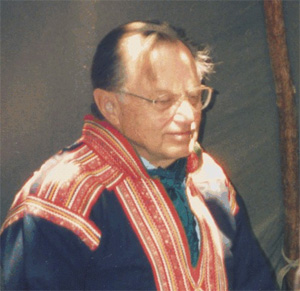RUDOLPH JOHNSON (*03.07.1916-†01.12.2007) IN MEMORIAM

A few days ago we got the sad message that Rudy (Rudolph) Johnson had left us, on Friday January 12 2007. He was born in Kirkenes in North-eastern Norway of parents with Norwegian and Sámi ancestry. His grandfather was of the reindeer herder Porsanger clan of Kárasjohka and he also had relations to reindeer people of Guovdageaidnu. He became a member of the Oslo Sámi Association in 1957 that served as a national meeting place for Sámit since 1951. Apart from being a war veteran after the second world war, he became professor he has always been closer to his Sámi origin.
First time I met Rudy was in December 1976 when in Minneapolis en route to Duluth where he lived with his family. During my stay I was interested in meeting Indigenous peoples, and this was the first Indigenous Immigrant I had met so far, some friends had ,mentioned that there was a librarian in Duluth who had introduced coloured and native American books and programs at that University. As we went northwards by bus, because he had never owned a car, he told me enthusiastically about the increasing contact he had with Lapp people and institutions in his original homeland. He told me he subscribed to periodicals, and newspapers like Sagat, «and now they even got a map with only Lapp place names, I will show it to you when we get home.» It was a pleasure to inform him who had made it. It was my habit since I came abroad, to correct the Lapp term for Sámi, and I suggested that he follow up on that, which he gladly did. In fact some time later he told me that he had got the Library of Congress in Washington DC to correct it as well, and the term «Lapp» is almost vanished from the English language now, at least in updated circles. It was new to me that so many Sámi Americans even existed. Of course I knew about the project of Reindeer herders from Sápmi in Alaska. So eventually I learned that among the many immigrants from Scandinavia a long time ago there were also many Sámi. He told me of one lady from the north that during the voyage across the Atlantic found it comfortable only of she could stay in the freezing room! She must have been a Sámi woman, or perhaps a Nenets, in any case an Arctic person, and they were many migrating to North America.
We came to their beautiful home in uptown Duluth with a good view of Lake Superior. It was snow and sun, like a beautiful winter day at home. His wife Solveig (Sally) is a painter, with a similar artistic background as myself. They have two sons and a daughter, one of their sons Kai had already studied Sámi language in Karasjohka, and spoke it well. Rudys mother was also there sitting in her rolling chair with her handwork knitting. She asked if I knew Árdni was, a large island (Arnøy in Norwegian) in Romsa/Troms county used by her relatives for summer pasture of their reindeer herd. She spoke a little Sámi, but would rather speak Norwegian, a child of the time of harsh assimilation policy. She told Rudy as a child in Duluth:«Speak English, people will think we are foreigners». Rudy was pleased to learn that racism against Sámi had weakened in Norway since he and his family left, among other things for just such reasons. But if they thought they could escape racism by leaving Northern Norway for USA, they were wrong. But Rudy did whatever he could to correct it, and as professor of the University of Minnesota in Duluth, he organised book collections and reading rooms for both coloured and native American students. I treasure the time shared with Rudy and his family, it means a lot to me. I see him as a hero and the main reason for the now strong Sámerican conscience. Rudy was also a prolific writer, and his article «A Sami View of Norwegian American Ethnicity» is a must for anyone interested in ethnicity, and who wouldn't be? I was privileged to know this family and to be able to invite them to the Nana/Indigenous Days festival in 1998, when Sally had her art exhibition at the Arctic Gallery here in Romsa/Tromsø. The loss the family must feel, especially Rudys wife, fills my heart with many prayers and wishes for them. It is a comfort that Arden Johnson, their eldest son, is taking up and continuing the work making Sámi American culture known for the treasure it on both sides of the Atlantic.
Elle-Hánsa/Keviselie/Hans Ragnar Mathisen